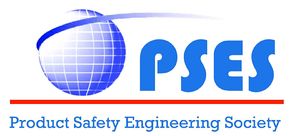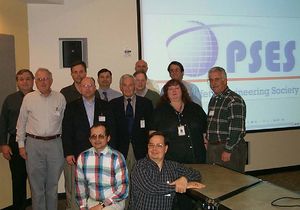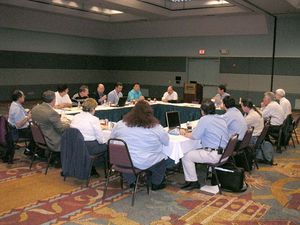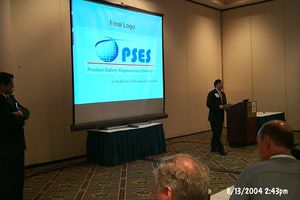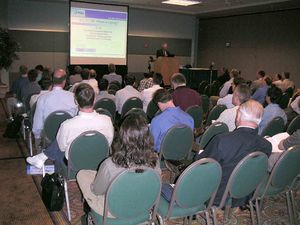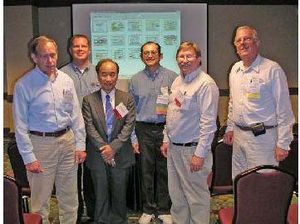IEEE Product Safety Engineering Society History
Creating a New Society
On 21 June 2003, the Institute of Electrical and Electronic Engineers (IEEE), through its Technical Activities Board (TAB), voted to create a new professional society, Product Safety Engineering. TAB is the functional operations unit that oversees activities of all Societies and Councils, including Division Directors and liaisons from other entities within IEEE. The Product Safety Engineering Society (PSES) becomes Society number 38 or S43.
The difference between a Society and Council is significant. A Society has dues paying members that receive benefits from membership. A Council has no dues paying members. Councils consist of two or more Societies with a common interest. Those Societies that wish to join a Council send a liaison to sit on the Council’s Board of Directors.
This article describes the effort required to attain IEEE society status, define various acronyms commonly heard, and to detail years of service to the product safety community through a newsletter, on-line web resources, and professional development through ad hoc chapters. The basic organization that started this process became unprecedented in size, constituency and lifespan. Its vitality was never taken for granted by those familiar with other organizational attempting to create a forum for safety engineers. Our history indicates there always has been a need for a professional association.
The Need for a Safety Organization
The need for a safety organization originally arose because of service-oriented issues with the Canadian Standards Association (CSA). In the winter of 1985, Richard Pescatore of Hewlett Packard in Cupertino, California, started action to resolve problems in receiving CSA approvals on HP products. Soon afterwards, engineers from local companies decided to form a joint industry-based organization with similar goals, since many were having the same problem in getting CSA approvals. They called themselves the CSA Users’ Group (CSAUG).
Word of this group quickly spread among more safety engineers through personal contact, especially with help of UL (Underwriters Laboratories) engineers, taking a stab at their friendly neighbor north of the border since their title was the “CSA” User’s Group. Around 1987, this group shifted its focus from CSA service concerns to general technical issues in an attempt to move a “bitch group” to a higher level and to address professional topics of concern. Participants decided not to target any specific agency or standard. The primary focus at that time was for those working in the IT Industry, which included UL, VDE, and other safety organizations worldwide. Trying to get any product safety approved using UL 114/478, CSA C22.2-No. 154/220, IEC 380/435, VDE 0875, etc., was becoming more difficult to achieve because of lack of harmonization.
The CSA User’s Group members discussed which organization to align with to bring legitimacy to this ad hoc group of engineers. They wanted CSA to it recognize it as an industrial society and not merely a small group of angry manufacturers. After much discussion, it was decided to pursue an association with the IEEE because of its international standing as a professional engineering association and not simply a trade group.
The net result of this organization allowed for:
- Turning an unsatisfactory situation with CSA into a positive one.
- Becoming a valuable resource for information and advice on product safety when none had existed, especially with the numerous non-harmonized safety standards in use at the time.
- Providing a newsletter to help fellow engineers learn about safety issues, technical problems, and to provide solutions.
- Increasing communication between engineers (both industry and agencies) involved with product safety for better and more consistent application of the requirements.
- Giving product safety engineers a place to meet other engineers with similar professional interests.
Chronological history
To best describe the history of the CSA User’s Group, its transformation into the Product Safety Society, the Product Safety Technical Committee of the EMC Society, Product Safety Committee (temporary) and finally the IEEE Product Safety Engineering Society, a bulleted chronology is utilized. Following the chronology are details about the Product Safety Newsletter (paper version), followed by a description of the virtual community that is in existence today.
Information and accuracy is based on input from the founders of this organization and archives of the Product Safety Newsletter, paper edition.
- December 1985. Disgruntled product safety (and EMC) engineers were popping up all over Silicon Valley to address problems they were having with CSA in trying to understand special requirements of this agency. Standards or procedures related to testing, report generation, follow-up service, and the like, were different from those used by UL and European safety test agencies. CSA appeared to interpret safety requirements that placed a significant burden on manufacturers and that lacked consistency within the IT industry. This frustration maximized in the winter of 1985 when Richard Pescatore at Hewlett Packard called a meeting with safety engineers from other companies. It was time to take action. Those who attended this meeting included Mario Gomez, John McBain, Roger Volgstadt, Ken Warwick, Dave Adams, Brian Claes, Dave Hanttula, and Lee Ould Jr., along with others whose names have been lost to history.
- Early 1986. CSA was invited to HP Palo Alto, California in an attempt to address service concerns.
- Mid 1986. The Product Safety Manager at Apple Computer (Mario Gomez) volunteered to host a lunch meeting. Problems were discussed and ideas brainstormed. The consensus was that a letter be written and sent to CSA from the perspective of a concerned industry organization and not just one company. Richard Pescatore wrote the letter. The attendees decided to call themselves the “CSA User's Group.”
- Early 1987. A working group was developed, gaining members from the San Francisco Bay area. The founders of this ad hoc group observed significant interest among engineers active in product safety approvals.
- Mid 1987. It was decided to evolve this growing User’s group into a formal organization, possibly going professional. To help facilitate communication among engineers, local chapters were formed. In the spring of 1987, the CSA User’s Group expanded to become the San Francisco Bay Area CSA User’s Group.
- October 1987. The CSA Users Group evolved into the Product Safety Society, an organization for product safety professionals without an official umbrella organization to support this operation. Becoming affiliated with the IEEE was a dream in the eyes of the founders.
- December 1987. The first technical meeting of the Product Safety Society was held in Cupertino, California at Apple Computer. Letters were sent outside the SF Bay Area to safety engineers (friends) describing the need to create local chapters.
- February 1988. The first issue of the Product Safety Newsletter (PSN) was released (detailed in the next section). Circulation grew to 800 in the course of a year. The following month, in Issue 2 of PSN, a petition to the IEEE to create a new society was included along with a Charter and Strategy statement.
- March 1988. A second chapter was formed in the Pacific Northwest shortly after Santa Clara’s became established, the first chapter. Chapters also formed a few months later in Denver (Steve Tarket), Southern California (Charlie Bayhi), and New England (Boston–Jim Norgaard). [Note: The New England chapter of the Product Safety Society evolved to become the Northeast Product Safety Society (NPSS) and decided to operate separately from sister chapters. NPSS still exists as an outstanding organization, deciding to become a chapter of PSES in 2005. They continue to have significant membership, monthly meetings, a vendor night, and hosting technical programs].
- May 1988. Within 2 months, over 120 signatures were collected on the petition. IEEE rules required only 100 to become a society. IEEE was officially contacted regarding formation of a Society (PSN, Vol. 1, No 3). Upon recommendation from IEEE TAB, we were advised to align ourselves with an IEEE Society to gain knowledge and experience as an IEEE entity. It was decided the EMC Society would be the society of choice because of the close working relationship between product safety and EMC engineers. There were now four active chapters nationwide up and running with monthly meetings.
- August 1, 1988. Richard Pescatore met with the IEEE EMC Society Board to Directors in an effort to become a Technical Committee. At that time, the process to becoming an IEEE Society was to be a Technical Committee of a Society, evolve into a Technical Council (gather support from other societies and critical mass), and then petition to become a Society after years of existence as a viable entity within the IEEE infrastructure. The EMC BOD voted to create TC-8, Electromagnetic Product Safety. This was the first step to becoming a society with Rich the first Chairman. The name “Product Safety Society” officially died and was replaced unofficially with Product Safety Technical Committee (PSTC). At this point of time, there was no differentiation between TC-8 and PSTC, which was later (1994) to become a major point of discussion over levels of responsibility and our future existence.
- January 1989. TC-8 begins operation. Members of the first board were Richard Pescatore/Chairman, Jim Norgaard/Vice Chairman, John McBain/Secretary-Treasurer, Tania Grant/Standards Committee, Mike Harris/Paper Review, Roger Volgstadt/Communications.
- 1990. First participation with a Safety Workshop at the IEEE EMC Symposium (Mark Montrose was the first Symposium Chair of TC-8 and stayed in this position for nearly 10 years).
- 1991. New officers of TC-8 were elected. Brian Claes becomes Chairman.
- 1991-1998. Under Brian’s leadership, the focus on TC-8 was to achieve critical mass and establish itself as a viable entity within IEEE.
- 1994. The IEEE (through TAB) was approached by members of TC-8/PSTC regarding creation of a Technical Council or Society on Product Safety. Because of administrative issues, i.e., lack of critical mass, no financial level of support, lack of publications, no conferences, etc., we were told to meet the minimal requirements for recognition by IEEE and come back in the future. It typically takes 3-5 years from this first introduction to establish a Technical Committee/Council in a manner that would be accepted by the IEEE as a Society.
- 1994. A significant development between EMC and TC-8 occurred. Because of TC-8’s discussions with IEEE earlier in the year, officers of EMC learned details about how its Technical Committee was operating as a dual-function unit (that is, both as a standard technical committee and as a group that had local meetings and a newsletter). This caused concern that was unpleasant to the EMC leadership. Something had to be done to separate the functions of a Technical Committee (TC-8) from that of PSTC. As reported by Brian Claes in PSN, Vol. 8, No. 1 (January-February 1995), “The existence of PSTC will cease to exist. For the last six years we have formally existed as a technical committee of the EMC Society but in reality have functioned more as an IEEE society. The EMC Society leadership in the past has been very tolerant in allowing us the freedom to function as we have; however; there has been a change of [EMC] leadership and TC-8 has been directed to reform itself to function as a traditional technical committee. TC-8’s scope will be restricted to electromagnetic safety and all participants must be members of IEEE’s EMC Society.” PSTC was operating as a (non-existent) society and not as a Technical Committee under TC-8, with bank accounts, chapters, newsletters, etc. This was against IEEE’s policies and procedure, as Technical Committees can have none of these attributes. By charter, a Technical Committee within a society has only 4-6 core members, no more. By agreement between officers of TC-8/PSTC and the President of EMC, Warren Kesselman, PSTC was redefined as the Product Safety Working Group (PSWG) under the supervision of TC-8, thus legitimizing PSTC as a sub-entity under TC-8 without official affiliation to EMC. This newly re-defined ad hoc group of engineers numbered over 1,000 and was nicknamed “the blob.” The acronym PSWG never caught on, and PSTC remained the preferred name of this group.
- December 1994. The e-mail list server “EMC-PSTC@IEEE.ORG” began with a very limited distribution. The system administrators were safety engineers and members of PSTC, not EMC.
- 1995. TC-8 reorganized itself to function per the charter of EMC, which was to focus on Symposium activities and technical paper reviews. PSTC aspects of TC-8 went into a holding pattern that lasted five years, with the loss of official support from the EMC Society to organize itself into a functional entity. Three choices were presented to the membership of PSTC (via) PSN for a vote; (1) Reform as an independent product safety society, (2) Reform as an IEEE Technical Council, (3) Align with the IEEE Environmental Health and Safety Committee. It was by majority vote of PSTC members to continue some form of affiliation with the IEEE, or with another organization.
- 1998-2000. Murlin Marks was elected chairman of TC-8. Work continued on establishing critical mass of PSTC and researching appropriate means of evolution, all while maintaining TC-8 per its charter by
the EMC Society. PSTC remained an unofficial working group under TC-8, with frustration by many who worked hard to create this organization.
- 2000-2002. Jack Burns was elected chairman of TC-8. Jack took the helm in putting together a team of dedicated individuals to re-kindle the flames previously created by Rich Pescatore. Since the officers of TC-8 and PSTC were the same, a steering committee was established to re-investigate becoming an IEEE Society or Technical Council. The primary members of this committee were Jack Burns, Daniece Carpenter and Mark Montrose (now a member of the Board of Directors of the EMC Society in addition to having been a member and officer of TC-8 and PSTC for nearly 10 years).
- 2000. Mark Montrose was directed by the EMC Society’s BOD to spin-off PSWG from TC-8. Times had changed. It was now the desire of the board to help PSWG/PSTC become an autonomous Council or Society within IEEE (i.e., dissolve the 1000+ members of PSWG), as EMC was unable to support a working group of this size under TC-8.
- February 2002. The TC-8 steering committee members formally organized themselves with a business plan. Jack Burns and Daniece Carpenter (co-chairs) and Mark Montrose (committee member) approached IEEE TAB in Phoenix, Arizone, and presented a proposal to create a new Society to the 51 members of TAB. A motion was approved to create, in principal, a Product Safety Committee (PSC) to develop the infrastructure and administrative issues to become a society. TAB provided financial assistance to help this committee advance to Stage 2. The life span of PSC was to be short lived; dissolved voluntarily or upon the ultimate creation of a Society or Council within IEEE.
- February 2003. Jack, Daniece and Mark appeared before TAB for a second time, one-year later. The business plan had been rewritten, a financial budget developed, bylaws and constitution created, and other logistics worked on in this year time-period. Underwriters Laboratories provided a grant of USD $25,000 to help fund this new society, courtesy of Kevin Ravo (UL-Santa Clara). It had been nearly 20 years since a Technical Committee approached TAB to become a Society (Society on Social Implications of Technology) and TAB had “no idea how to create a society from a technical committee, or from scratch!” For years, only Technical Councils could become Societies. Presidents of several Councils that eventually evolved into a Society fought against PSC since “they had to go through the Council route first.” Additional homework and political negotiations were required, among other administrative logistics. The vote to continue for three more months on the development of a new society by the PSC was approved by a narrow margin of 27-22.
- June 2003. After much work in only three months, Jack, Daniece and Mark appeared before TAB for one last time. All necessary concerns were addressed in writing and the presentation was polished. This time, PSC was able to achieve a unanimous vote of TAB to create a new society beginning 1 January 2004. One key issue for approval was to change the name of the society from Product Safety to Product Safety Engineering.
- November 2003. The initial Board of Directors of the new Product Safety Engineering Society (PSES) had to be approved by TAB management, since the society had no members to elect officers. The first BOD is by appointment from the Vice President of TAB (a member of the BOD of IEEE), based on recommendation from PSC and the Presidents of various Societies within TAB.
- January 1, 2004. A new society begins operation. The acronym PSTC “officially” dies as of this date, to be replaced by PSES.
Through the 1990's, the PSTC/PSWG was an anomaly from IEEE's perspective. Both parties benefited during our awkward relationship. We were very large from the beginning, and quickly became larger than some IEEE societies. We followed a natural and instinctive growth path in order to meet pent-up needs and so functioned like a society in many ways. In spite of the structural adjustments we had to make, we kept our focus primarily on directly serving the product safety professional, even if it was as a dual personality organization.
The Product Safety Newsletter
Spurred on by the success of local groups and interested engineers in promoting the field of product safety, John McBain, Ken Warwick and Roger Volgstadt met and expressed interest in writing a newsletter. Since John and Ken already were involved in other duties with the group, Roger drew the short straw and became its editor. The first issue (Volume 1, No. 1) was mailed out in February of 1988 (dated March 1988) and included a Chairman's Message and Chapter Activity reports. The second issue has a column created by Rich Nute called Technically Speaking. This column clearly became the main reason why people wanted to get on the mailing list.
In June of 1996 (nearly 10 years later), the PSN staff realized that the effort to create a print copy newsletter required a significant amount of time, energy, effort and money. With a tiring staff and shortage of income from Institutional Listings, a decision to stop mailing hard copies and start a web-based publication was made, based on surveys in the PSN on what type of services readers desired. It became apparent that a list server, or email forum was the item of interest most sought after by readers. The last paper edition published was Vol. 11, No.1, January-March, 1998.
In December 1994, the list server “EMC-PSTC” began operation. Notification of a virtual email community was sent to as many relevant e-mail addresses as Roger Volgstadt had from his days as editor of the paper edition of the Newsletter. This email forum was not designed to replace the newsletter, but was created to provide a service for safety engineers similar to what another list server provided in the field of telecom “TREG” (telecommunication regulations - treg@world.std.com).
The only entity that could provide necessary list server functions was the IEEE. In 1994, email was still new and chat rooms rare. After a few weeks of phone messages to the IEEE, a new administrator volunteered to take on the assignment of creating a virtual community and was able to formalize development of “EMC-PSTC@ieee.org,” along with a list of guidelines and option details. Using the guidelines that the list server TREG had as a template, a similar guideline was created for “EMC-PSTC.”
Roger Volgstadt served as the first administrator of “EMC-PSTC” for about a year before retiring. He spent nearly 10-years as Editor-in-Chief of PSN and the first list server administrator. Rich Nute and Ed Price, along with a few other volunteers were gracious enough to take over the administrative needs of the list sever, handling behind-the-scene activities that continue to this day. The forum quickly became a popular tool for asking questions and sharing information among the product safety community, as well as the EMC community. It is amazing to see how a simple idea, at the right time in the evolution of technology, has benefited so many people.
During Roger’s term as PSN Editor, there was wonderful support from a variety of authors including Pete Perkins, Lal Bahra, Paul Hill and Rich Nute. In the paper version of the Newsletter, there was a tongue-in-cheek series called "Ask Dr. Z" (a.k.a. Dave Adams). For awhile the PSN had cartoons from Richard Tennant ("The 5th Wave"). The following did yeomen's duties behind the scenes for a number of years to see that the publication was successful: Ken Warwick, John McBain, Dave Lorusso, Brian Claes and Ron Baugh. The PSN paper version grew from small monthly issues to a quarterly circulation of over 1300 people at its peak, with a lot of pages to collate and stamps to lick four times a year.
By this time, the newsletter became difficult to create because of the massive amount of labor to produce it and a tired, weary staff. With the interest of members wanting to go virtual, seeking greater depth of information, it became apparent that the safety profession would greatly benefit from a more formal structure. As a result, a web based virtual community, hosted by IEEE within a year after the email reflector started, replaced the paper edition of the newsletter. This virtual community was a concept-based project within IEEE to see if what we wanted to achieve was possible. This led us into the creation of our now formal virtual community.
Recognition should be given to the following companies that helped support this group in its first years of existence: Apple Computer and Hewlett Packard (publication support/meeting rooms), Tandem Computers (publishing support), and Applied Materials (meeting rooms).
Creation of a Formal Virtual Community/Society
In 2001, PSTC (Rich Nute and Jim Bacher) established the formal Product Safety Virtual Community using a software vendor the IEEE provided (http://ieeepstc.mindcruiser.com/). During IEEE's early attempt to establish a prototype virtual community, PSTC, the "EMC-PSTC" list server was utilized to beta test new software. The vendor Mindcruiser was eventually sold to another company. After the sale, the new organization failed to properly support and resolve issues that developed. As a result, IEEE changed software providers and we moved to http://www.ieeecommunities.org/emc-pstc at the start of 2003. The email list server remains the most active part of PSES.
As a benefit of IEEE Society membership, the BOD of PSES decided to become a virtual community (saves money and allows for faster, more professional means of operation). Once entering the “www.ieee-pses.org” web site, a member only section is found. Using ones’ IEEE membership number and a password, members of PSES will have exclusive access to a Transactions/Journal, technical papers, conference records, goods and services, and other benefits that will be offered to members. Non-society members will have access only to the upper portion of the Society web page and unlimited access to the list server.
Since creation of PSES by TAB, support has been received from other Societies that wish to establish cooperative relations for conference sharing, publications and other items of interest to the product safety engineering community worldwide.
The First Five Years - The Beginning of a New IEEESociety
Creating a new Society within the IEEE took many years of hard work with a team of dedicated engineers and interested parties. Once created, the real work began. Creating a Society was a challenge, but we never realized the magnitude of work that would be required to kick-start the Society into operation.
The first Board of Directors meeting was held at Dell Computer, Austin, Texas. Per the Bylaws, the Administrative Committee (ADCOM) was to consist of six experienced directors or board members from other Societies within the IEEE, appointed by the Division Directors Forum (Division Directors sit on the Board of Directors of the IEEE), and six members appointed by the Product Safety steering committee which created the Society through the IEEE Technical Activities Board (TAB).
Unfortunately, only one experienced director showed up. The six safety volunteers (appointees) had no experience or knowledge in IEEE administration. This left us to figure out how to create an ADCOM to the new Society’s president, Mark Montrose, who had been appointed to the position by the president of the IEEE and its Board of Directors. Henry Benitez was appointed president-elect of the Society at this first meeting. Both the president and the president-elect were sitting members of the IEEE EMC Society and thus had some fundamental knowledge of IEEE ADCOM experience at the Society level.
The first action item (using a bottle of water as the gavel) was to figure out who would assume the offices of vice-president (there are four VPs in the Society), as well as term limits of one, two or three years until a complete elected board had been established by the membership, per our transitional bylaws. When there were two volunteers for a position, the decision on who got the job was settle using that time-honored decision breaking protocol; rock, paper, scissors. In fact, at our first meeting, we had no idea if we had any members or not! It would be a year before we learned how many joined this new Society in its first year of existence.
Once the ADCOM was established with senior leadership (Executive Committee, EXCOM, i.e., the president, president-elect, vice-presidents, secretary and treasurer), we had to figure out the task assignment of each office and discuss how to develop an infrastructure that would provide benefit to Society members, which were very few due to minimal marketing of our new Society by IEEE. That’s because we were the first new Society to be established from a Technical Committee in nearly 20 years, and our business model did not fit into the realm of typical marketing and merchandising normally performed when a Council was created.
A “Council” is similar to a “Society,” except that Council members are Societies with an affinity for a particular “field of interest,” but have no direct or individual members. IEEE had only listed us in their membership renewal brochure, and had not issued a press release. That made our new Society the best kept secret within the IEEE, a Society that nobody in the world knew about because IEEE did not know how to announce us. This, despite our having made representations to the senior management at the IEEE that our new Society would one day have over 1,500 members!
We started out with a $25,000 grant from Underwriters Laboratories, no publication, no newsletter, no conferences, no chapters, no infrastructure, no policies nor procedures, no history, and no gavel. Essentially, we got to create our destiny with a clean sheet of paper. This is what some call having fun!
The Annual Symposium
The biggest concern for the Board was figuring out how to establish benefits that would make product safety engineers want to join a new Society that had nothing to offer except the prestige of being a charter member. So it was decided to hold a Product Safety Engineering Symposium in the very first year of the Society’s existence. Henry Benitez was named to chair the symposium. Benitez formed a committee with Richard Nute as technical program chair, Richard Georgerian as vice-chair, and Daniel Arnold as treasurer. That group, along with an abundance of inexperienced but enthusiastic volunteers, succeeded in putting on a very successful Symposium in record time.
The Symposium was held in Santa Clara, CA as a follow-on to the IEEE EMC Symposium. Santa Clara seemed to be the perfect place for our new Society’s first Symposium, as that is where the Society got its start in the late 1980s. It also allowed the new Product Safety Engineering Society (PSES) to attract EMC members who were attending the EMC Symposium and who were also interested in product safety.
Rich Nute did a stellar job putting together the technical program. With such a wealth of product safety information and no prior forum for sharing, the technical program was overwhelming. Exhibits were open throughout the Symposium, although they looked like a ghost town during the technical sessions. Subsequent conferences were restructured so that the exhibit hall was open only during breaks and lunch, permitting vendors to attend paper sessions.
In 2004, one of the first action items for the PSES Board of Directors was to create a logo. Accordingly, a contest was held, with the members of the Society choosing our logo from numerous entries received. The winning logo was presented at the 2004 Symposium, submitted by a team of safety engineers from Siemic, located in China. This showed the IEEE and the IEEE TAB that the PSES was an international society from the beginning.
In 2005, our second Symposium was held in Chicago, IL, and was co-chaired by Richard Georgerian and Ken Thomas. This gave us very little time to implement the lessons that we learned from our first Symposium. In 2006, the Symposium was held in Irvine, California with co-chairs Richard Georgerian and Bansi Patel. (We found out again the hard way that California does not rebate sales taxes to non–profits, resulting in a financial loss for the Society and the Symposium.) In 2007, the Symposium was in Longmount, CO, with Richard Georgerian and Bansi Patel once again co-chairing the event.
The 2008 Symposium will be in Austin, TX, and will be expanded by half a day to 2-1/2 days to accommodate the desires of attendees and the increase in the number of paper submittals. For 2009, the Society is traveling to Toronto, Canada in an effort to expand beyond the United States. As for future Symposia, we hope to hold one in Taiwan within the next few years.
For many years, product safety engineers had to attend other conferences containing one or two sessions on product safety in workshop or tutorial format. Through our annual Symposia, the IEEE PSES now provides to product safety engineers excellent and high-quality, professionally-concentrated safety technical sessions. However, it may take a few years to have members and other product safety engineers realize there is an IEEE Symposium that caters strictly to their interest in product safety.
Local Chapters and Other Offerings
A significant achievement within our first year of existence was the formation of 10 local chapters. These chapters were existing product safety oriented sub-chapters of local IEEE EMC Society chapters that now had a new “home” society to report to. Current U.S. chapters include Santa Clara, Central Texas, Oregon, Rochester NY, Orange County, Chicago and Central New England. Three of our Society’s ten chapters are outside the continental United States, in Israel, Taipei Taiwan and Vancouver British Columbia.
In 2004, the PSES signed an agreement with the International Association for Radio, Telecommunications and Electromagnetics (iNarte), a professional association that certifies engineers as competent product safety professionals. The IEEE PSES is the only safety organization worldwide that offers professional accreditation of safety engineering through iNarte.
In 2005, Gary Weidner accepted the Editor-in-Chief position for the Society newsletter, which allowed us to publish our first newsletter as an IEEE Society, and not as a Technical Committee of the IEEE EMC Society. This newsletter was renamed from the Product Safety Newsletter to the Product Safety Engineering Newsletter. In 2006 the newsletter was expanded to 4 issues a year. In 2007 Rich Nute started to rewrite his famous “Technically Speaking” column.
We continue to work to develop benefits that members can enjoy, and to generate revenue to meet our expenses. In 2003, we attempted to launch a Society Journal, but were unable to establish a sufficient backlog of papers that would support a minimum required count for a yearly series, resulting in the loss of approval from the IEEE TAB. As a substitute, the Society has developed the eDJ (electronic Digital Library) to showcase published papers.
Economic Challenges and the Road Ahead
As one might assume, the first two years of the PSES were challenging, with a mission to create an international society without any infrastructure or money. We achieved some success, but still had a long way to go. Henry Benitez took over as the PSES president in 2006. His term was known as the financial struggle era.
Under Henry, unforeseen changes in how the IEEE TAB allocated publication revenue pushed the PSES to the point of extinction. To combat this, Henry emphasized the need for “quantum improvements” for increasing membership and revenue. Pressure was placed on increasing attendance and revenue from the annual Symposium, since it was the primary source of revenue for the society.
After many months of struggle, Henry was able to resolve the problems with the TAB revenue distribution. He also helped established the Technical Committee structure, and brought the Society newsletter on-line, while continuing to hold successful annual Symposia.
Jim Bacher followed Henry Benitez in year five (2008-2009). Under Jim’s leadership, the Society is now becoming a smooth functioning Society. Almost every element within our Business Plan has been achieved. Technical Committees are now functioning, and include Hazard Based Safety Engineering, Functional Safety, Information Technology Equipment, Medical Equipment, National Electric Code, Forensics, and Education. Other Technical Committees that may be established includes Consumer Electronics and Appliances, and Industrial Equipment. And, PSES membership continues to increase at a time when most IEEE societies are loosing members.
As a benefit of PSES membership, the Society’s Board of Directors is increasing its efforts to build a more dynamic virtual community, which saves money and allows for faster, more professional means of operation. The Society web site (www.ieee-pses.org) includes much information, and the “Members Only” section offers many benefits that are not available to the general public. Using ones’ IEEE membership web account and a password, PSES members have exclusive access to technical papers, goods and services, past newsletters, a job networking arena, and the ability to participate in technical activities sponsored by the society, plus significant discount on conference registration fees, and unlimited access to the listserve emc-pstc@ieee.org, which has been in continuous operation since 1986.
Conclusion
Since creation of the PSES, support has been received from other IEEE Societies, test agencies and test laboratories, and corporate sponsors. Our sponsors seek to ensure the viability of the Society in all facets of operation, which includes participation in conferences, trade journals, publications and other areas of interest to the product safety engineering community worldwide. For our Society and our Symposium to continue, we need to increase our membership enough to hit critical mass. If you believe that what we are doing is the right thing to do, please join us!
Acknowledgement
This article is was written by
Mark I. Montrose
Champion and First President (2004-2005)
IEEE Product Safety Engineering Society
Are you a member of this society? Please help expand the article by using the edit tab.
